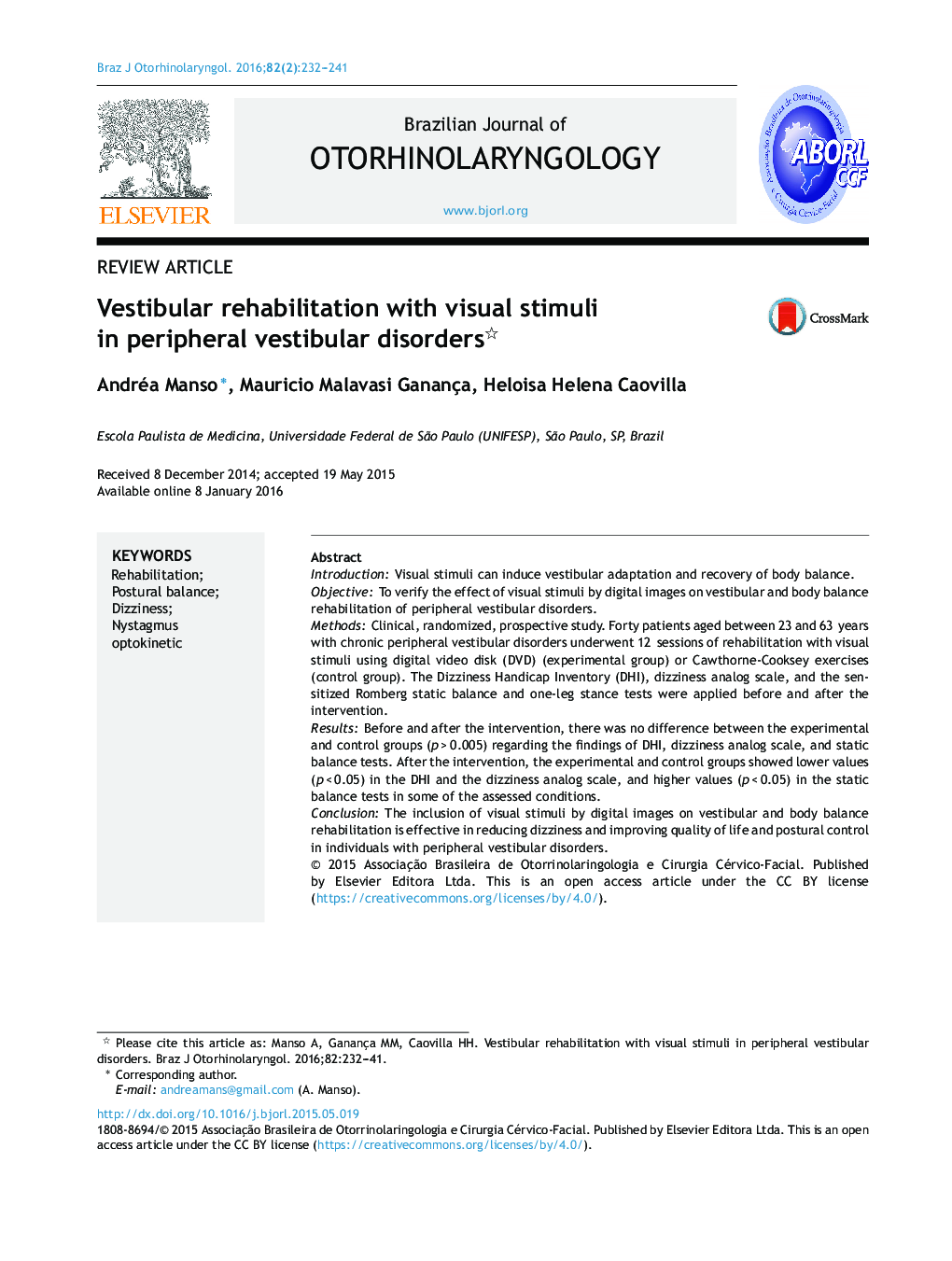| کد مقاله | کد نشریه | سال انتشار | مقاله انگلیسی | نسخه تمام متن |
|---|---|---|---|---|
| 4106089 | 1605362 | 2016 | 10 صفحه PDF | دانلود رایگان |

IntroductionVisual stimuli can induce vestibular adaptation and recovery of body balance.ObjectiveTo verify the effect of visual stimuli by digital images on vestibular and body balance rehabilitation of peripheral vestibular disorders.MethodsClinical, randomized, prospective study. Forty patients aged between 23 and 63 years with chronic peripheral vestibular disorders underwent 12 sessions of rehabilitation with visual stimuli using digital video disk (DVD) (experimental group) or Cawthorne-Cooksey exercises (control group). The Dizziness Handicap Inventory (DHI), dizziness analog scale, and the sensitized Romberg static balance and one-leg stance tests were applied before and after the intervention.ResultsBefore and after the intervention, there was no difference between the experimental and control groups (p > 0.005) regarding the findings of DHI, dizziness analog scale, and static balance tests. After the intervention, the experimental and control groups showed lower values (p < 0.05) in the DHI and the dizziness analog scale, and higher values (p < 0.05) in the static balance tests in some of the assessed conditions.ConclusionThe inclusion of visual stimuli by digital images on vestibular and body balance rehabilitation is effective in reducing dizziness and improving quality of life and postural control in individuals with peripheral vestibular disorders.
ResumoIntroduçãoEstímulos visuais podem induzir a adaptação vestibular e recuperar o equilíbrio corporal.ObjetivoVerificar o efeito de estímulos visuais por imagens digitais na reabilitação do equilíbrio corporal de vestibulopatias periféricas.MétodoEstudo clínico, randomizado, prospectivo. Quarenta pacientes com vestibulopatia periférica crônica e idade entre 23 e 63 anos foram submetidos à 12 sessões de reabilitação com estímulos visuais em DVD (grupo experimental) ou aos exercícios de Cawthorne-Cooksey (grupo controle). Dizziness Handicap Inventory (DHI), escala visual analógica de tontura e testes de equilíbrio estático de Romberg sensibilizado e de apoio unipodal foram aplicados antes e após a intervenção.ResultadosAntes e após a intervenção, não houve diferença entre os grupos experimental e controle (p > 0,005) no DHI, escala visual analógica e testes de equilíbrio estático. Após a intervenção, o grupo experimental e o controle apresentaram valores menores (p < 0,05) do DHI e da escala visual analógica de tontura e valores maiores (p < 0,05) nos testes de equilíbrio estático em algumas condições avaliadas.ConclusãoA inclusão de estímulos visuais por imagens digitais na reabilitação do equilíbrio corporal é eficaz na redução da tontura, na melhora da qualidade de vida e do controle postural de vestibulopatias periféricas.
Journal: Brazilian Journal of Otorhinolaryngology - Volume 82, Issue 2, March–April 2016, Pages 232–241